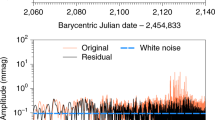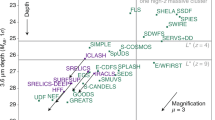Abstract
Surface gravity is a basic stellar property, but it is difficult to measure accurately, with typical uncertainties of 25 to 50 per cent if measured spectroscopically1,2 and 90 to 150 per cent if measured photometrically3. Asteroseismology measures gravity with an uncertainty of about 2 per cent but is restricted to relatively small samples of bright stars, most of which are giants4,5,6. The availability of high-precision measurements of brightness variations for more than 150,000 stars7,8 provides an opportunity to investigate whether the variations can be used to determine surface gravities. The Fourier power of granulation on a star’s surface correlates physically with surface gravity9,10: if brightness variations on timescales of hours arise from granulation11, then such variations should correlate with surface gravity. Here we report an analysis of archival data that reveals an observational correlation between surface gravity and root mean squared brightness variations on timescales of less than eight hours for stars with temperatures of 4,500 to 6,750 kelvin, log surface gravities of 2.5 to 4.5 (cgs units) and overall brightness variations of less than three parts per thousand. A straightforward observation of optical brightness variations therefore allows a determination of the surface gravity with a precision of better than 25 per cent for inactive Sun-like stars at main-sequence to giant stages of evolution.
This is a preview of subscription content, access via your institution
Access options
Subscribe to this journal
Receive 51 print issues and online access
$199.00 per year
only $3.90 per issue
Buy this article
- Purchase on Springer Link
- Instant access to full article PDF
Prices may be subject to local taxes which are calculated during checkout



Similar content being viewed by others
References
Valenti, J. & Fischer, D. A. Spectroscopic properties of cool stars (SPOCS). I. 1040 F, G, and K dwarfs from Keck, Lick, and AAT planet search programs. Astrophys. J. 159, 141–166 (2005)
Ghezzi, L. et al. Stellar parameters and metallicities of stars hosting Jovian and Neptunian mass planets: a possible dependence of planetary mass on metallicity. Astrophys. J. 720, 1290–1302 (2010)
Brown, T. M., Latham, D. W., Everett, M. E. & Esquerto, G. A. Kepler Input Catalog: photometric calibration and stellar classification. Astron. J. 142, 112–129 (2011)
Chaplin, W. J. et al. Ensemble asteroseismology of solar-type stars with the NASA Kepler mission. Science 332, 213–216 (2011)
Huber, D. et al. Testing scaling relations for solar-like oscillations from the main sequence to red giants using Kepler data. Astrophys. J. 743, 143–152 (2011)
Stello, D. et al. Asteroseismic classification of stellar populations among 13,000 red giants observed by Kepler. Astrophys. J. 765, L41–L45 (2013)
Basri, G. et al. Photometric variability in Kepler target stars: the Sun among stars – a first look. Astrophys. J. 713, L155–L159 (2010)
Basri, G. et al. Photometric variability in Kepler target stars. II. An overview of amplitude, periodicity, and rotation in the First Quarter data. Astron. J. 141, 20–27 (2011)
Mathur, S. et al. Granulation in red giants: observations by the Kepler mission and three-dimensional convection simulations. Astrophys. J. 741, 119–130 (2011)
Kjeldsen, H. & Bedding, T. R. Amplitudes of solar-like oscillations: a new scaling relation. Astron. Astrophys. 529, L8–L11 (2011)
Brown, T. M., Gilliland, R. L., Noyes, R. W. & Ramsey, L. W. Detection of possible p-mode oscillations on Procyon. Astrophys. J. 368, 599–609 (1991)
Gilliland, R. L. et al. Kepler mission stellar and instrument noise properties. Astrophys. J. 197 (suppl.). 6–24 (2011)
Strassmeier, K. G. Starspots. Astron. Astrophys. Rev. 17, 251–308 (2009)
Borucki, W. J. et al. Kepler planet-detection mission: introduction and first results. Science 327, 977–980 (2010)
Burger, D. et al. An interactive web application for visualization of astronomy datasets. Astron. Comput. (in the press); preprint at http://arxiv.org/abs/1307.4000 (2013)
Fröhlich, C. et al. First results from VIRGO, the experiment for helioseismology and solar irradiance monitoring on SOHO. Sol. Phys. 170, 1–25 (1997)
Basri, G., Walkowicz, L. M. & Reiners, A. Comparison of Kepler photometric variability with the Sun on different timescales. Astrophys. J. 769, 37–49 (2013)
Brown, T. M. & Gilliland, R. L. Asteroseismology. Annu. Rev. Astron. Astrophys. 32, 37–82 (1994)
Christensen-Dalsgaard, J. Physics of solar-like oscillations. Sol. Phys. 220, 137–168 (2004)
Chaplin, W. J. & Miglio, A. Asteroseismology of solar-type and red giant stars. Annu. Rev. Astron. Astrophys (in the press)
Dumusque, X., Udry, S., Lovis, C., Santos, N. C. & Monteiro, M. J. P. F. G. Planetary detection limits taking into account stellar noise. I. Observational strategies to reduce stellar oscillation and granulation effects. Astron. Astrophys. 525, 140–151 (2011)
Kjeldsen, H. & Bedding, T. R. Amplitudes of stellar oscillations: the implications for asteroseismology. Astron. Astrophys. 293, 87–106 (1995)
Henry, G. W., Fekel, F. C., Henry, S. M. & Hall, D. S. Photometric variability in a sample of 187 G and K giants. Astrophys. J. 130 (suppl.). 201–225 (2000)
Gilliland, R. L. Photometric oscillations of low-luminosity red giant stars. Astron. J. 136, 566–579 (2008)
Schröder, C., Reiners, A. & Schmitt, J. H. M. M. Ca II HK emission in rapidly rotating stars. Evidence for an onset of the solar-type dynamo. Astron. Astrophys. 493, 1099–1107 (2009)
Chaplin, W. J., Elsworth, Y., Isaak, G. R., Miller, B. A. & New, R. Variations in the excitation and damping of low-l solar p modes over the solar activity cycle. Mon. Not. R. Astron. Soc. 313, 32–42 (2000)
Komm, R. W., Howe, R. & Hill, F. Solar-cycle changes in GONG p-mode widths and amplitudes 1995–1998. Astrophys. J. 531, 1094–1108 (2000)
Chaplin, W. J. et al. Evidence for the impact of stellar activity on the detectability of solar-like oscillations observed by Kepler. Astrophys. J. 732, L5–L10 (2011)
Bastien, F. A. et al. Radial velocity variations of photometrically quiet, chromospherically inactive Kepler stars: a link between RV jitter and photometric flicker. Astron. J (submitted)
Pinsonneault, M. et al. A revised effective temperature scale for the Kepler Input Catalog. Astrophys. J. 199 (suppl.). 30–51 (2012)
Acknowledgements
The research described in this paper makes use of Filtergraph (http://filtergraph.vanderbilt.edu), an online data visualization tool developed at Vanderbilt University through the Vanderbilt Initiative in Data-intensive Astrophysics. We acknowledge discussions with P. Cargile, K. Carpenter, W. Chaplin, D. Huber, M. Paegert, M. Sinha and D. Weintraub. We thank D. Huber and T. Metcalfe for sharing the average asteroseismic parameters of Kepler stars with us. F.A.B. acknowledges support from a NASA Harriet Jenkins Fellowship and a Vanderbilt Provost Graduate Fellowship. F.A.B. and K.G.S. acknowledge NSF PAARE grant AST-0849736.
Author information
Authors and Affiliations
Contributions
F.A.B. and K.G.S. contributed equally to the identification and analysis of the major correlations. F.A.B. principally wrote the first version of the manuscript. K.G.S. prepared the figures. G.B. calculated the variability statistics of the Kepler light curves and performed an independent check of the analysis. J.P. checked against biases in the datasets. All authors contributed to the interpretation of the results and to the final manuscript.
Corresponding author
Ethics declarations
Competing interests
The authors declare no competing financial interests.
Supplementary information
Supplementary Information
This file contains Supplementary Text and Supplementary Figures 1-3. (PDF 1707 kb)
Supplementary Data
This file contains a machine-readable table corresponding to Supplementary Figure 2. (TXT 32 kb)
Rights and permissions
About this article
Cite this article
Bastien, F., Stassun, K., Basri, G. et al. An observational correlation between stellar brightness variations and surface gravity. Nature 500, 427–430 (2013). https://doi.org/10.1038/nature12419
Received:
Accepted:
Published:
Issue Date:
DOI: https://doi.org/10.1038/nature12419
This article is cited by
-
Exoplanet mass estimation for a sample of targets for the Ariel mission
Experimental Astronomy (2022)
-
Chronos - take the pulse of our galactic neighbourhood
Experimental Astronomy (2021)
-
Weighing stars from birth to death: mass determination methods across the HRD
The Astronomy and Astrophysics Review (2021)
-
Common dynamo scaling in slowly rotating young and evolved stars
Nature Astronomy (2020)
-
These labs are remarkably diverse — here’s why they’re winning at science
Nature (2018)
Comments
By submitting a comment you agree to abide by our Terms and Community Guidelines. If you find something abusive or that does not comply with our terms or guidelines please flag it as inappropriate.



